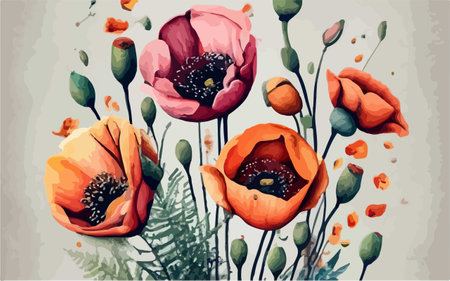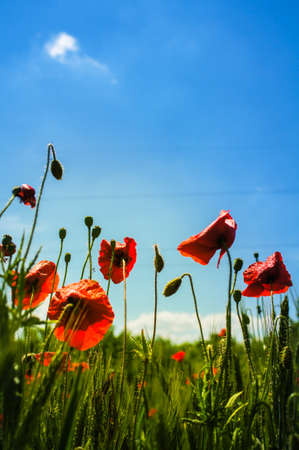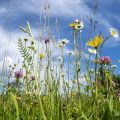Introduction to Wildflower Meadows
Wildflower meadows are vibrant, open spaces filled with a rich variety of native grasses and flowers. Unlike manicured lawns or agricultural fields, these meadows grow naturally, supporting countless species of plants, insects, and birds. In Britain, wildflower meadows are especially valued for their beauty and ecological importance. They stand out as unique landscapes because they reflect centuries of traditional land management and the country’s diverse climate. Each meadow offers a tapestry of colour that changes with the seasons, making them a cherished part of the British countryside. Their rarity today makes them even more special, symbolising both the natural heritage and cultural identity of Britain.
2. Historical Origins and Development
Wildflower meadows in Britain have deep roots that stretch back centuries, reflecting a harmonious relationship between people and the land. Traditionally, these meadows emerged as a by-product of low-intensity, mixed farming systems that were prevalent before the advent of modern agriculture. Farmers would allow fields to grow naturally throughout spring and early summer, cutting them for hay in late July or August, after most wildflowers had set seed. This method was not only practical but also encouraged a rich diversity of native plants and supported local wildlife.
Traditional Farming Practices
The management of wildflower meadows relied on age-old techniques passed down through generations. These practices included rotational grazing, periodic cutting, and careful control of soil fertility. Fertilisers were seldom used, which prevented aggressive grasses from outcompeting delicate wildflowers. Below is a simple comparison of traditional versus modern meadow management:
| Aspect | Traditional Management | Modern Management |
|---|---|---|
| Fertiliser Use | Minimal or none | Frequent application |
| Grazing | Rotational with rest periods | Continuous or intensive grazing |
| Hay Cutting Time | After flowering and seeding | Earlier, often before seed set |
| Biodiversity Support | High plant and animal diversity | Lower diversity due to uniformity |
The Evolution Over Time
The rise of industrial agriculture in the twentieth century brought significant changes. The use of chemical fertilisers, reseeding with high-yield grasses, and more frequent mowing led to a dramatic decline in traditional wildflower meadows across Britain. It is estimated that over 97% of these meadows have been lost since the 1930s. However, growing awareness of their ecological value has sparked renewed interest in preserving and restoring these habitats.
A Living Heritage
Today, surviving wildflower meadows are treasured as living links to Britain’s rural heritage. Their continued existence depends on thoughtful stewardship and the revival of traditional methods adapted for modern times. These landscapes remain symbols of sustainable land use and cultural continuity throughout the British countryside.

3. Ecological Importance and Biodiversity
Wildflower meadows are vital to the ecological health of Britain’s landscapes. These vibrant habitats support a remarkable variety of native wildlife, acting as a lifeline for species that have declined elsewhere due to intensive farming and urbanisation. The rich tapestry of wildflowers provides food and shelter for countless insects, birds, and small mammals. In particular, pollinators such as bees, butterflies, and hoverflies rely heavily on meadows for nectar throughout the spring and summer months.
The diversity of plants in wildflower meadows creates a balanced ecosystem where each species plays a part in supporting others. Native grasses and flowers attract different insects, which in turn become food for birds like skylarks and meadow pipits. Small mammals such as voles and shrews find cover among the dense growth, while predatory species including barn owls benefit from this abundance of prey.
Meadows also contribute to soil health by preventing erosion and enhancing fertility. Their deep-rooted plants help improve soil structure, allowing rainwater to filter through more easily and reducing flooding risk. By supporting complex food webs and sustaining rare species, wildflower meadows are essential for maintaining Britain’s natural heritage and promoting biodiversity across rural and even urban environments.
4. Meadows in British Folklore and Art
Wildflower meadows have long held a special place in the British imagination, weaving their way into local myths, literature, and visual arts. These vibrant landscapes often symbolise purity, peace, and the unspoiled beauty of nature. In folklore, meadows are sometimes depicted as enchanted places where fairies gather or as settings for magical happenings, reflecting the deep-rooted connection between the natural world and the mystical in British storytelling.
Meadows in Myths and Folklore
Across Britain, traditional tales frequently feature wildflower meadows as meeting spots for mythical beings such as elves and fairies. For example, in Cornish folklore, it is believed that dancing in meadows under the full moon could lead to encounters with fairy folk. These stories contributed to the notion of meadows as liminal spaces—places where the ordinary world meets the supernatural.
Influence on Literature
British poets and authors have often drawn inspiration from wildflower meadows. Writers like William Wordsworth and John Clare celebrated meadows for their beauty and tranquillity. Their works evoke vivid imagery of colourful blooms swaying in the breeze, symbolising harmony and renewal. The meadow setting appears in countless classic novels and poems, acting both as a backdrop for rural life and as a metaphor for freedom or innocence lost.
Notable Literary References
| Author | Work | Description of Meadows |
|---|---|---|
| William Wordsworth | The Prelude | Describes wandering through flower-filled meadows as a source of joy and inspiration. |
| John Clare | The Shepherds Calendar | Praises the seasonal changes in meadows and their role in rural tradition. |
| A.E. Housman | A Shropshire Lad | Uses meadow landscapes to evoke nostalgia and fleeting youth. |
Representation in Visual Arts
The allure of wildflower meadows extends into British painting and illustration. From Pre-Raphaelite artists to contemporary landscape painters, meadows are portrayed as scenes of idyllic beauty or moments of peaceful contemplation. Artists such as John Constable captured the lushness of English countryside meadows, highlighting their role in shaping national identity through art.
Cultural Impact Summary
Through centuries of myth, literature, and art, wildflower meadows have come to represent more than just botanical diversity—they embody the spirit of Britains cultural heritage. Their recurring presence across creative forms continues to inspire reverence for nature and underscores their lasting influence on the collective imagination.
5. Decline and Conservation Efforts
Wildflower meadows, once a common sight across the British countryside, have experienced a dramatic decline since the mid-20th century. According to studies, over 97% of traditional wildflower meadows in the UK have disappeared since the 1930s. This loss is largely due to changes in agricultural practices, such as the intensification of farming, widespread use of fertilisers and pesticides, and land being converted for development or intensive grazing.
Main Causes of Decline
Modern agriculture prioritises productivity, often at the expense of biodiversity. The removal of hedgerows, frequent mowing, and reseeding with fast-growing grasses all contribute to the loss of native wildflowers. Urban expansion has also played a role, with meadows being replaced by housing and infrastructure projects. These changes have had a profound impact on local ecosystems, reducing habitats for pollinators like bees and butterflies and diminishing natural beauty.
Conservation Initiatives
Recognising the importance of wildflower meadows, numerous conservation initiatives have been launched across Britain. Organisations such as Plantlife and The Wildlife Trusts are actively working to restore and protect remaining meadows through public awareness campaigns, seed collection programmes, and practical restoration projects. Government-supported schemes encourage farmers and landowners to manage their fields in more wildlife-friendly ways by maintaining traditional haymaking methods or allowing natural regeneration.
The Role of Communities
Local communities play a vital role in conservation efforts. Many villages and towns now support wildflower planting on road verges, school grounds, and public spaces. Citizen science projects invite individuals to monitor wildflower populations and report sightings, helping to track progress and inform future actions. Through these combined efforts, there is hope that Britain’s wildflower meadows can be preserved for future generations to enjoy.
6. Modern Relevance and Community Involvement
Today, wildflower meadows are experiencing a revival across Britain, as people rediscover their beauty and ecological importance. Once considered remnants of the countryside, these meadows are now being reintroduced in both rural and urban settings. Many local councils and community groups have launched urban wildflower projects, transforming parks, roadside verges, and even roundabouts into vibrant patches of native blooms. These initiatives not only support pollinators like bees and butterflies but also offer city dwellers a taste of traditional British landscapes.
Urban Wildflower Projects
In cities such as London, Manchester, and Edinburgh, wildflower meadows are becoming a common sight. Local authorities often partner with schools and environmental charities to sow native seeds and manage green spaces in sustainable ways. These projects provide hands-on learning opportunities for children and foster a sense of stewardship among residents. The visual impact is immediate—colourful swathes of poppies, cornflowers, and oxeye daisies brighten up otherwise grey urban environments.
Festivals and Public Events
The renewed interest in wildflower meadows has inspired a range of festivals and public events across the UK. Annual celebrations like National Meadows Day invite people to visit local meadows, join guided walks, and participate in seed-planting workshops. Such events highlight the cultural significance of these habitats while encouraging communities to protect them for future generations.
Appreciation for Native Flora
There is also a growing appreciation for native British flora in gardening trends and conservation efforts. Many Britons now choose to plant wildflowers in their own gardens or allotments, recognising their value for wildlife and the unique character they bring to outdoor spaces. This movement reflects a broader shift towards sustainability and biodiversity in British culture, ensuring that the legacy of wildflower meadows continues to thrive in modern life.


